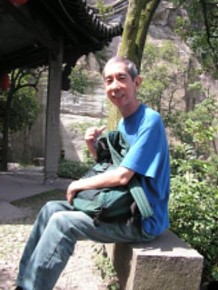Healing 'Frozen Shoulder' with Taiji Quan
by Kim Foong
 I
started learning Taiji about five years ago from Master Chong as a
beginner. Six months later, I stopped learning as my work schedule
clashed with the Taiji class. During the break, I did not practise
Taiji Quan.
I
started learning Taiji about five years ago from Master Chong as a
beginner. Six months later, I stopped learning as my work schedule
clashed with the Taiji class. During the break, I did not practise
Taiji Quan.
It was during that period that I was struck by two health problems. Firstly, whenever I squatted down I could not stand up again no matter how hard I had tried. I needed to hold on to some object to help me to get up or use my hands to 'push' my body up from the ground. However, this did not seem to be a big problem because there was no pain or discomfort.
The second one was serious. My friends told me that I was suffering from the so called 'frozen shoulders', a kind of RSI (Repetitive Strain Injuries) – a common syndrome among the middle age or people who use a lot of computer. Whenever I raised my arms, my shoulders would be badly hurt – so painful that tears sometimes came out. I did not have good sleep as I would wake up few times a night because my shoulders were hurting while I turned my body. All the movements requiring me to raise my hands became painful and frustrating tasks – changing, bathing, holding on to the rail in the bus or train, pressing a bus stop button etc.
I went for Acupuncture treatment but gave up after one session as there was no improvement.
At the same time, I rejoined Master Chong's Taiji class without the expectation that Taiji Quan could heal or alleviate my RSI problem. Although I was suffering from 'frozen shoulders' I did not have too much difficulty in doing the warm-up exercise and the Taiji steps - there are not many movements that need me to raise my hands up above my shoulder. After two weeks, there was some noticeable improvement to my 'frozen shoulder'. The Taiji warm-up exercise especially, such as vibrating the arms, rotating the shoulder joints was very helpful. I was learning the Dao Nian Hou step then, and the arm movements seemed to soothe the pain of my shoulders. Being encouraged by the improvement, I put in more effort and practise these movements few times a day.
My 'squatting' problem was completely gone after one month. In the second month, my shoulder pain was much alleviated. I could raise my arms slightly higher without hurting my shoulder and sleep soundly every night. By the end of third month, I was fully recovered. Other than one acupuncture treatment, I did not go for other forms of therapy. However, I did change my work habit such as taking a break every hour and doing relaxation exercise to reduce the stress on my arms.
Master Chong's warm-up exercise is devised to prepare the body for performing Taiji Quan. It loosens the muscles and joints, and it also helps to strengthen the muscles (please refer to 'Taiji Quan - Body of Knowledge' by R. Chong and G. Loo, Pepper Publications, 2004) . I have found Master Chong's warm-up exercise and Taiji Quan movements very useful in healing RSI such as the 'frozen shoulders' that I had suffered.
I have learned a lesson. Since then, I have not stopped practising Taiji Quan. Besides that there is no relapse of the RSI symptom, I am also getting fitter and healthier. IT workers or people who use computer intensively are easily the victims of RSI. They should consider taking up Taiji Quan to prevent or to heal the injuries.
Lim Kim Foong
October 2007